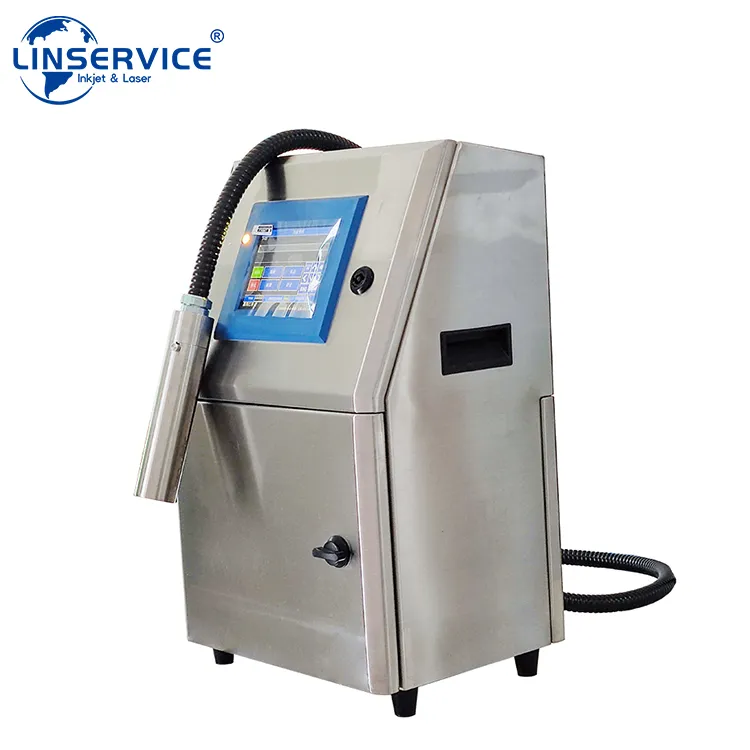Continuous Inkjet Printer Applications Transform Industrial Printing
Continuous Inkjet Printer
In a rapidly evolving industrial landscape, continuous inkjet printers are emerging as game-changers, revolutionizing the way manufacturers mark, code, and trace products. Known for their versatility, speed, and reliability, CIJ printers are becoming indispensable across various sectors, from packaging and food production to pharmaceuticals and electronics.

Enhanced Efficiency in Packaging and Labeling
One of the primary applications of continuous inkjet printers is in the packaging industry. These printers are ideal for high-speed production lines, capable of printing clear, legible codes on a variety of substrates, including plastics, glass, metals, and paper. With their ability to operate continuously without frequent maintenance, CIJ printers significantly boost production efficiency. This is particularly important in fast-moving consumer goods (FMCG) industries, where downtime can lead to substantial financial losses.
Precision Coding in Food and Beverage Industry
In the food and beverage sector, continuous inkjet printers are crucial for ensuring product traceability and compliance with regulatory standards. These printers can print batch numbers, expiration dates, and barcodes directly onto packaging, helping manufacturers meet stringent food safety regulations. The non-contact printing technology of CIJ printers is especially advantageous for maintaining the integrity of food packaging, ensuring that labels remain intact and legible throughout the product's shelf life.
Reliable Marking in Pharmaceuticals
Pharmaceutical companies rely heavily on CIJ printers for precise and reliable marking on their products. Given the critical importance of traceability and authenticity in this industry, CIJ printers provide a robust solution for printing unique identifiers, lot numbers, and manufacturing dates on blister packs, bottles, and cartons. The ability to print on small, curved surfaces with high accuracy ensures that vital information is consistently readable, reducing the risk of counterfeiting and ensuring patient safety.
Versatility in Electronics Manufacturing
The electronics industry also benefits from the versatility of continuous inkjet printers. These printers can handle a wide range of materials used in electronic components, such as circuit boards, cables, and connectors. The fine, high-resolution printing capabilities of CIJ printers make them suitable for adding complex codes and small text to electronic parts, facilitating efficient inventory management and quality control. Additionally, the quick-drying, permanent inks used in CIJ printers ensure durable markings that withstand the rigors of electronic manufacturing processes.
Environmental and Cost Benefits
Continuous inkjet printers not only enhance operational efficiency but also offer environmental and cost benefits. Modern CIJ printers use environmentally friendly, solvent-based inks that are less harmful to the environment compared to traditional inks. Furthermore, their high efficiency and low maintenance requirements result in reduced waste and lower operating costs. The ability to use a single printer for multiple applications and substrates also contributes to cost savings, as it reduces the need for multiple printing systems.
Real-World Success Stories
Numerous companies have successfully integrated continuous inkjet printers into their production lines, reaping significant benefits. For instance, a leading dairy producer adopted CIJ printers to streamline their milk packaging process. The printers' ability to operate continuously without frequent cleaning reduced downtime, while their precise coding capabilities ensured compliance with food safety regulations. This transition not only increased the company’s productivity but also improved the traceability of their products.
Similarly, a global electronics manufacturer implemented CIJ printers to enhance their component labeling process. The printers’ high-speed, accurate printing allowed the company to maintain strict quality control standards while keeping up with the high demands of the electronics market. The result was a more efficient production process and a marked improvement in product traceability and quality assurance.
Future Innovations
Looking ahead, the continuous inkjet printer market is poised for further innovation. Advances in digital technology and automation are expected to enhance the capabilities of CIJ printers, making them even more efficient and user-friendly. For example, the integration of IoT (Internet of Things) and AI (Artificial Intelligence) technologies will enable real-time monitoring and predictive maintenance, further reducing downtime and optimizing production processes.
In conclusion, Continuous inkjet printers are transforming industrial printing with their unmatched efficiency, versatility, and reliability. From ensuring food safety and pharmaceutical traceability to enhancing electronics manufacturing and packaging, CIJ printers are setting new standards in industrial marking and coding. As technology continues to evolve, the role of CIJ printers in driving productivity, sustainability, and innovation across various industries is expected to grow even more significant.
 English
English Español
Español Português
Português русский
русский français
français 日本語
日本語 Deutsch
Deutsch Tiếng Việt
Tiếng Việt Italiano
Italiano Nederlands
Nederlands ไทย
ไทย Polski
Polski 한국어
한국어 Svenska
Svenska magyar
magyar Malay
Malay বাংলা
বাংলা Dansk
Dansk Suomi
Suomi हिन्दी
हिन्दी Pilipino
Pilipino Türk
Türk Gaeilge
Gaeilge عربى
عربى Indonesia
Indonesia norsk
norsk اردو
اردو čeština
čeština Ελληνικά
Ελληνικά Українська
Українська Javanese
Javanese فارسی
فارسی தமிழ்
தமிழ் తెలుగు
తెలుగు नेपाली
नेपाली Burmese
Burmese български
български ລາວ
ລາວ Latine
Latine Қазақ
Қазақ Euskal
Euskal Azərbaycan
Azərbaycan slovenský
slovenský Македонски
Македонски Lietuvos
Lietuvos Eesti Keel
Eesti Keel Română
Română Slovenski
Slovenski मराठी
मराठी Српски
Српски 简体中文
简体中文 Esperanto
Esperanto Afrikaans
Afrikaans Català
Català עִברִית
עִברִית Cymraeg
Cymraeg Galego
Galego Latvietis
Latvietis icelandic
icelandic יידיש
יידיש Беларус
Беларус Hrvatski
Hrvatski Kreyòl ayisyen
Kreyòl ayisyen Shqiptar
Shqiptar Malti
Malti lugha ya Kiswahili
lugha ya Kiswahili አማርኛ
አማርኛ Bosanski
Bosanski Frysk
Frysk ជនជាតិខ្មែរ
ជនជាតិខ្មែរ ქართული
ქართული ગુજરાતી
ગુજરાતી Hausa
Hausa Кыргыз тили
Кыргыз тили ಕನ್ನಡ
ಕನ್ನಡ Corsa
Corsa Kurdî
Kurdî മലയാളം
മലയാളം Maori
Maori Монгол хэл
Монгол хэл Hmong
Hmong IsiXhosa
IsiXhosa Zulu
Zulu Punjabi
Punjabi پښتو
پښتو Chichewa
Chichewa Samoa
Samoa Sesotho
Sesotho සිංහල
සිංහල Gàidhlig
Gàidhlig Cebuano
Cebuano Somali
Somali Точик
Точик O'zbek
O'zbek Hawaiian
Hawaiian سنڌي
سنڌي Shinra
Shinra հայերեն
հայերեն Igbo
Igbo Sundanese
Sundanese Lëtzebuergesch
Lëtzebuergesch Malagasy
Malagasy Yoruba
Yoruba Javanese
Javanese Divih
Divih Philippine
Philippine Gwadani
Gwadani Kurde
Kurde



Application of TTO Printer
Thermal transfer printer (TTO Printer) plays an important role in modern industry and is widely used in many fields, especially in the food, medicine, daily necessities and electronic product packaging industries. Its main function is to print the production date, shelf life, barcode and other information on various packaging materials through thermal transfer technology.
Read More24mm TTO Printer VS 32mm TTO Printer
24mm TTO printers and 32mm TTO printers have their own characteristics in technical specifications and are suitable for different needs. 24mm TTO printers usually attract SMEs with their compact design and lower cost, suitable for printing smaller barcodes and labels, and the speed can usually reach 300mm per minute. In contrast, 32mm TTO printers offer a wider printing format, suitable for larger packages, and can also reach a speed of 400mm per minute, suitable for efficient production lines. Both support a variety of ink types and have excellent print clarity and durability, which can meet the needs of different industries.
Read MoreHow Does a UV Laser Marking Machine Work?
The working principle of a UV laser marking machine revolves around the process of photochemical ablation. When the UV laser beam hits the surface of a material, it breaks the molecular bonds directly without generating significant heat, unlike traditional laser marking methods. This “cold” marking process ensures that the surrounding material is not damaged or altered, which is particularly beneficial for marking sensitive materials like plastics, glass, and certain metals.
Read More